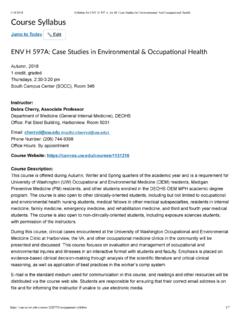Transcription of Applied Learning - Case Studies
1 Applied Learning - case Studies case Vignette 01 [Recommended discussion with Chapter 10, can also be discussed with Chapters 9 & 5] A client reports that he is feeling down and withdrawn lately. You notice that his movement and affect are slow and restricted. He is aware that he has become more isolated and doesn t find much satisfaction in his work anymore. At one time he enjoyed his work and took pride in his skill as a cabinetmaker, but lately he is having trouble completing the jobs he has and doesn t have the energy to go after new jobs. He tells you it is harder to get out of bed in the morning and he often doesn t return calls from friends or customers. He says this has been going on for the last four months and he feels completely stuck. He has become isolated from friends and ruminates over how he messed up past relationships. He says he drinks alcohol most nights - usually a few beers or wine with dinner.
2 Occasionally, he has a few shots of brandy before going to bed. When you encourage him to be more specific about his alcohol intake, ( how much wine and how many beers and when), he becomes irritated and dismisses your questions insisting that he doesn t believe he has problem with alchohol. Instructions Break into groups of 2 to 4 students to review case Study #1 - an alcohol abuser with major depressive disorder, and ask them to identify the following: What evidence indicates that the client has developed an alcohol use disorder? Are there indications that the client is abusing any other drugs? How could a medical condition, the abuse of alcohol and other drugs contribute to the emotional state and social isolation described by the client? Prioritize the clinical interventions that are necessary to treat this subject. Expert Review John Dedomenico, MS, MFT & Darryl S.
3 Inaba, PharmD., CADC III [General Theme: Assessing for Co-occurring Major Depression & Suicidality] Assessment & Diagnosis: Axis I - Symptoms of Major Depression (Assess for potential suicidal ideation & rule out Bipolar disorder) Axis I - Alcohol Abuse (active) possible Dependence Axis II - NOS insufficient evidence Axis III - No indications of a medical condition influencing Axis I Consider addressing the following treatment issues: Most will recognize this client is likely experiencing a major depressive episode. Most of the symptoms he describes meet the criteria for Major Depressive Disorder (MDD) as listed in the DSM IV. However, depressive disorder is never a flat depressive state. MDD will often have remissions in which a person will feel almost normal and this cycling effect can be confusing. There are many medical conditions that can cause depressive disorders; diabetes, anemia, hypothyroidism, infectious hepatitis, congestive heart failure, are just a few examples.
4 If the client has not had a full medical exam in the last year encourage them to get one. Bipolar disorder is another possibility. Even though the client has not reported any manic or hypo-manic symptoms, most patients with bipolar disorder do not seek help while in their manic or hypo-manic phase. It is more common for these patients to present during the depressive phase of their bipolar disorder. It is prudent to rule out this diagnosis with a psychiatric evaluation. Addictions treatment professionals must call upon a mental health professional to confirm or rule out the diagnosis of MDD. The counselor can assist with the MDD diagnosis by providing a comprehensive assessment of the client s alcohol and drug intake, amount and frequency of all types of alcohol need to be ascertained. Consider the diagnostic importance of a client who becomes angry or irritable when a counselor probes his history of alcohol or other drug usage.
5 Always ask about legal prescription and over the counter medications, (OTC s) as well as Illegal drugs. Examine the onset of current affective symptoms and make a correlation to the amount and/or frequency of alcohol/drug consumed especially if the amount has increased (tolerance) over the past several months. Probe to determine whether the client is occasionally drinking early in the day to offset his depression or alleviate the shakes after waking (tissue dependence and withdrawal). A complete history of use is vital, including any past attempts to decrease use, past addiction treatment, and family of origin addiction history. Onset of major depression that occurs after problematic alcohol use (for males under the age of 65, more than 4 drinks per occasion or more than 14 drinks per week) can be an alcohol induced mood disorder. Depressed mood prior to problematic use may be a self-medication for an underlying mood disorder.
6 Assist client in understanding the relationship of alcohol use and mood disorder and also help them understand the diagnostic criteria for abuse and/or dependence to ethanol. Remember that most who start to experience alcohol use problems often understate their use to clinicians. Alcohol is a depressant. Even minimal daily use can trigger insomnia, disrupt REM sleep and exacerbate depression. This is especially true if alcohol is used as a night-cap before bedtime. Consuming large amounts daily disrupts the natural sleep cycle and adds to the depression. Drinking caffeinated cocktails or energy drink cocktails may also contribute to MDD symptoms. These drinks combine liquor with an energy drink ( a Jagerbomb , a shot of Jagermeister and Red Bull ). A client s safety should be foremost when a patient presents with depressive symptoms. Counselors and therapists must make a suicide assessment.
7 Broaching the subject in a low key, matter-of-fact, but direct way is best. It seems you re really feeling down. Do you feel so hopeless you might consider suicide? It is not uncommon for people to have thoughts of suicide when they have no energy and are feeling down or isolated. A counselor/ therapist may feel uncomfortable about bring up the subject of suicide for fear of planting the notion in the patients head. However, if someone is thinking along these lines it can be a great relief for them to be asked about suicide in an empathic and non-judgmental way. It allows them to begin talking about their feelings in an open and direct manner and the counselor/ therapist can then help them process their feelings. Once the topic is broached, more specific questions can be asked. 1. Is the person thinking about suicide? If yes, do they have a plan? 2. If they have a plan, is their plan lethal, - will they succeed?
8 3. Is there a time frame? 4. When and where do they plan on carrying it out? Each positive response to these questions increases the danger that they are serious and therefore action must be taken - including breaching their confidentiality, if necessary, by notifying the police or other appropriate agencies to insure their safety. Discerning or predict that a person is in eminent danger of harming themselves is nearly impossible. One technique often used is to establish a no harm contract with the person, even though most experienced counselors will confirm the fact that no harm contracts mean nothing to a person who has made the decision to end their life. However, a signed contract provides the counselor or therapist with documentation that the issue was addressed. Keeping a client engaged and letting them know their clinical care providers are truly invested in their well being is critical.
9 It is important to increase the number of times a client contacts you ( phone check-ins and office sessions). Make referrals to a psychiatrist or local agency that can provide extra support and provide the number to a suicide prevention crisis line. If the symptoms are serious family and /or friends should be notified. Clinical staffs are generally advised to err on the side of safety. Pursue with the client their willingness to check themselves in to a hospital. If not, make a 911 call to let local police, who have the authority to detain clients for safety reasons, decide what steps must be taken for clients with current suicidal ideations. Severe alcohol withdrawal is another major safety consideration. Untreated, this can lead to life-threatening DTs and major seizures. If this is suspected, the client should be transferred to a location offering emergency medical services or to an addiction treatment facility that can provide medical detoxification.
10 If the client does not have any suicidal ideation or plan, ask if he would be willing to stop his alcohol consumption for the next couple of weeks. Explain that while providing temporary relief, alcohol is a depressant, and can exacerbate his symptoms of depression. Unwillingness to do this would indicate a more serious alcohol problem than he is aware of or an unwillingness to admit to. Sufficient information about his depression must be gathered. When did it begin? How long has it lasted? Has he felt down like this before? Does he feel better at times and then down again, at other times? An ebb and flow of mood is usual for Major Depressive disorders. By contrast feeling flat, lacking energy, harboring a why bother attitude, yet still managing to get out of bed and attend to a daily routine, are characteristic symptoms associated with Dysthymia. While Major Depressive episodes have characteristic cycles similar, but never to the extreme peaks and valleys of bipolar disorder, Dysthymia is flat and remains that way for years with little fluctuation.









